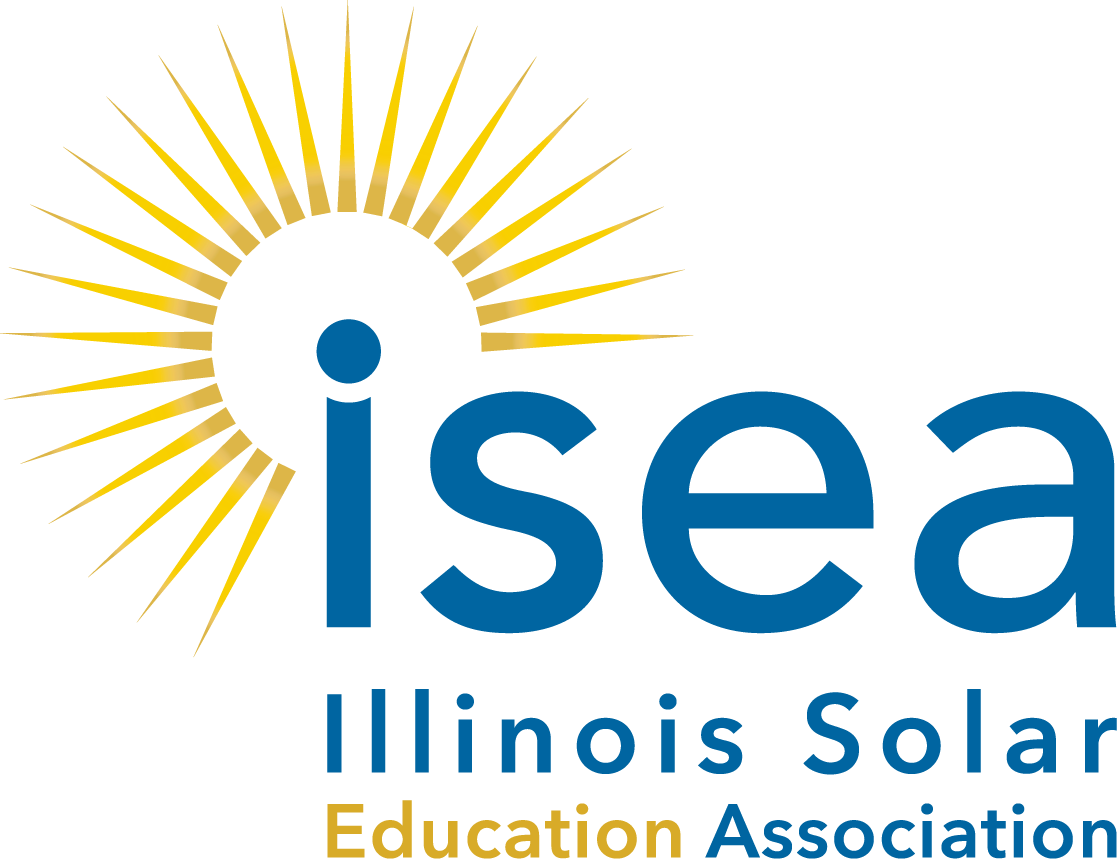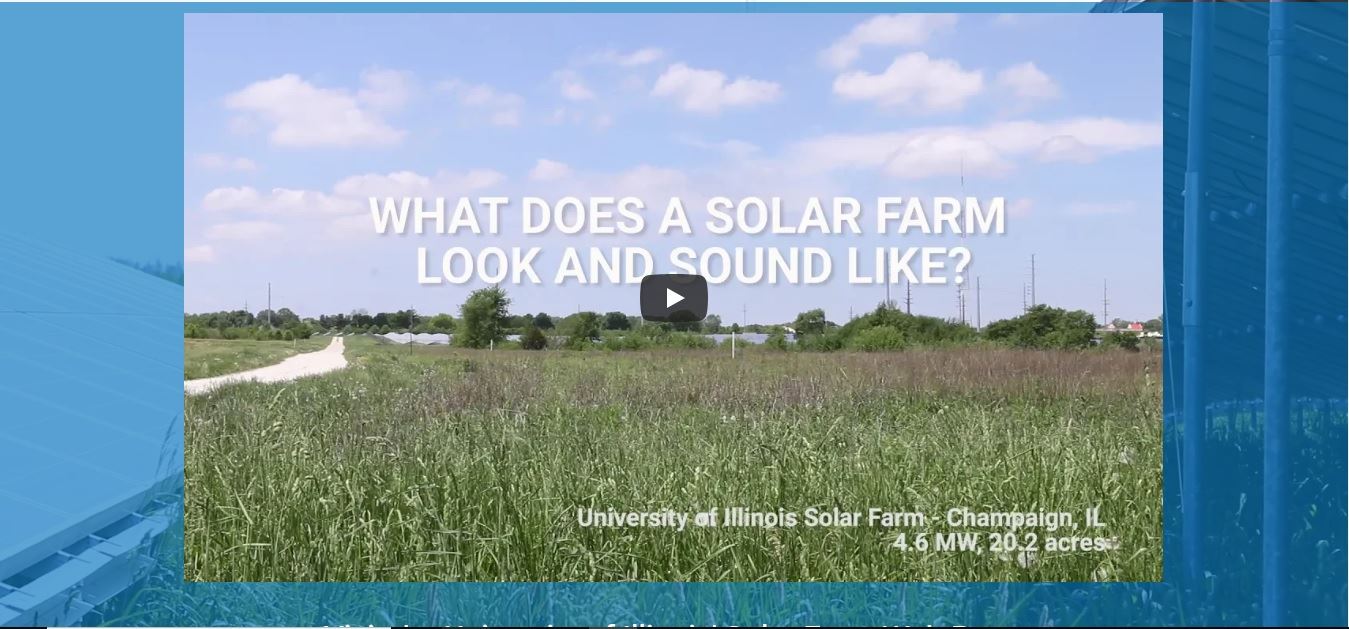FAQs - large-scale solar
The questions and answers below apply mainly to ground mounted solar projects as opposed to rooftop solar – which include: residential, business, community solar, as well as utility-scale farms. See the bottom of the page for sources.
To download a concise version to pass out at local meetings, click here.
Will living near a solar farm affect the value of my property?
It makes sense that neighbors would want to know if a solar project will affect their property values. The best way to answer this question is to look at data from real estate sales and assessments. Numerous local and national studies have shown that clean energy projects do not reduce nearby property values. Property valuation experts from CohnReznick have studied the value of properties that adjoin solar farms in Illinois and Indiana and concluded that the solar farms do not adversely affect the property values in either the short or long term. The study included solar farms in Lasalle and Winnebago Counties in Illinois; as well as Elkhart, Lake, Madison, Marion and Porter Counties in Indiana. Experts analyzed property sale prices and marketability of single family homes and agricultural land that adjoins solar farms and compared this data to comparable properties in the same county. The study also included interviews with county assessors and local real estate professionals, all of whom concluded that solar farms in their area had not impacted property values. Similar research has been conducted in other states across the U.S. and none of these studies have found that solar farms adversely affect nearby property values. While solar farms are quite different and much less visible than wind farms, it’s worth reviewing similar studies of wind energy. A U.S. Department of Energy-funded study of over 50,000 home sales in nine states found no statistical evidence that proximity to wind farms affects home values . A separate study looked at the values of 122,000 homes and found that wind farms did not affect property values. |
Can solar projects be located out of sight of homes and businesses?
Developers take care to locate projects as far as possible from residences, but there are a number of factors that are important to siting a solar farm effectively. Sometimes its necessary to build a project within view of residences. If built correctly, solar farms won’t change the look or feel of a community, even when they’re located near homes. We’ve seen examples across the country of solar farm coexisting with residential areas. At around 8-12 feet high, solar arrays have a low profile, and landscaping is often used to shield the project from view. ISEA encourages developers to customize landscape and project design to meet the needs of nearby residents. Unlike other types of energy generation, solar farms don’t create sound that’s audible outside the project, don’t consume water and don’t generate any type of pollution. It makes sense that we might see some electrical infrastructure during our daily routine. Solar is the safest and least obtrusive type of energy generation available. |
I understand that solar farms make money for the companies that own them and the landowners who host them, but what do they do for the communities where they’re located?
Solar projects provide lower electric bills, economic growth and increased energy independence for nearby communities.
A typical solar project will generate 30 years of steady tax revenue to fund schools and other community services while helping keep taxes low for homeowners. In addition to taxes, solar creates local construction and operations jobs and increased business for local services like hotels and restaurants.
Being close to solar generation means more reliable electric service for nearby homes and businesses and increased stability for the regional grid. Community solar projects will allow subscribers to lower their electric bills by purchasing clean energy while helping reduce pollution from coal and gas plants. New solar projects offer lower cost electricity than older, dirtier power plants.
Solar power creates these community benefits without the increases in traffic, noise or nuisances that accompany other kinds of development. Last but not least, clean solar power helps us reduce our reliance on fossil fuels which protects human health and fights climate change.
How much does solar power cost?
In addition to being pollution free, solar power is one of the lowest cost ways to generate electricity . Advances in solar technology dramatically have reduced the price of solar power in recent years, making it cheaper than coal, gas or nuclear in many cases. The better economics of solar is a big reason we’re deploying more solar today. And unlike the fluctuating costs of gas, coal or oil; solar power’s low costs are guaranteed never to increase in the future.
Does it make sense to build solar projects on farm land? Shouldn’t we be concerned about taking land out of production?
By hosting solar farms on their land, Illinois farmers can help feed the world and keep the lights on at the same time. Many agricultural producers are interested in diversifying their income by leasing some of their property to solar projects. It’s also important to note that there are 27 million acres of farmland in Illinois — solar energy production will never displace agriculture’s central role in Illinois’ economy, landscape and culture.
Solar projects are a temporary use of private land that can complement agriculture by helping farmers manage commodity price shifts, make money and protect their way of life. Solar lease agreements include a binding commitment that project owners will return land to its prior use once a project is complete.
Solar projects are typically planted with native grasses or wildflowers that improve soil and water quality and can be an important habitat for pollinators such as bees and butterflies, which make nearby farms more productive. There are currently about 900,000 acres of Illinois farmland that have been voluntarily taken out of production through the USDA’s Conservation Reserve Program (CRP). The majority of this CRP land is used to grow native plants and grasses that prevent erosion and protect soil and water quality , solar farms can create those same benefits.
What if the project is abandoned? Will the county be stuck paying to remove it?
There are lots of protections in place to make sure projects will be decommissioned at the end of their useful lives. Lease agreements and county solar ordinances will specify a developer’s responsibility for decommissioning projects and returning land to its prior use.
The solar industry has voluntarily worked with the Illinois Farm Bureau and the Department of Agriculture to agree to statewide standards that protect farmers and make it clear that solar developers are responsible for returning land back to its original use at the end of a project’s life.
Solar farms are constantly monitored and receive regular maintenance by professional technicians to make sure they’re operating well. Project owners who invest in solar projects have a business interest in keeping them operating properly.
Do solar panels contain toxic chemicals? Could solar facilities affect land or water quality for families living nearby?
Solar panels are safe to touch, attach to your home or install in your neighborhood. Panels are primarily made of glass, aluminum, copper and other common materials . Solar farms also utilize steel racks to position panels, electrical cable and a small number of inverters and electric transformers to deliver power to the grid. All of this equipment is safe and contains the same materials that are found in household appliances. There are trace amounts of chemicals in solar panels that enable them to produce electricity. These compounds are completely sealed within the glass and coatings of the panels.
After their useful life, solar panels and equipment are easy to disassemble and recycle. Solar facilities are constantly monitored, and the owners have a business interest in keeping them well-maintained and operating properly. Solar plants are designed to withstand severe weather, and panels are built to last for up to 40 years. If solar panels are damaged, they can be quickly replaced with new ones.
Do solar projects depend on taxpayer subsidies?
Solar projects are privately funded and are generally located on private land that is leased from the landowners. Operating projects in Illinois bid to sell power to customers through electric markets. Like any business, solar projects pay all applicable taxes.
While solar energy is privately funded, there are financial incentives available to project owners. The Federal Investment Tax Credit is in currently in place for solar power and is scheduled to phase out over the next four years. Illinois utilities also participate in competitive procurements for the environmental attributes of solar. Projects that successfully bid in these procurements receive Solar Renewable Energy Credits for the energy they produce.
Is the electric voltage at a solar project dangerous?
The electric current generated at solar panels is lower than the voltage in a home outlet. Electricity from a solar project travels through buried cables to a transformer, where voltage is increased so that it can feed into the electric grid. All the electric equipment on the site is secured and will not pose a risk to people or animals.
Do solar panels create glare?
Glare from solar panels is not a problem because PV solar panels are designed to absorb sunlight, rather than reflect it. Panels are made of dark colored materials and treated with anti-reflective coatings. The FAA has created standards to assess glare from solar facilities to ensure that they are safe for pilots flying nearby. Using these standards, the FAA has approved solar arrays near several major airports.
Do solar projects create electromagnetic fields?
Solar projects do not create electromagnetic fields that could be measured outside a project. Inverters used in solar facilities generate electromagnetic fields that are similar to household appliances, and many times weaker than those created by normal power lines. The weak electromagnetic fields from solar equipment can only be detected within around 150 feet of a solar farm’s inverters.
Do solar farms create a fire hazard?
PV solar projects are safe and do not use heat to generate electricity. Millions of solar panels have been safely installed on homes and rooftops around the world for decades – including more than 53,000 MW of solar in the US. All solar installations in the US are fully permitted and inspected by relevant local authorities including fire departments, incidents of any kind are extremely rare.
Do solar farms harm birds or wildlife?
Solar farms do not pose a threat to wildlife. Wildlife studies are an important part of solar development - trained experts study proposed sites to ensure that solar development minimizes impact to wildlife. Solar projects can also provide important habitat for pollinators like bees and butterflies that make farmland more productive.
Do solar farms increase runoff, erosion or flooding?
Solar farms do not increase runoff and will improve soil and water quality. Storm water management plans are a required part of the solar development process. These plans are prepared by professional engineers to ensure that projects don’t contribute to erosion or flooding. The land on a solar farm is not paved and can be covered with native plants that absorb rain and runoff and help recharge groundwater. Native grasses planted on solar farms create the added benefit of preventing erosion and improving soil quality.
Sources
- http://emp.lbl.gov/sites/all/files/lbnl-6362e.pdf
- http://files.masscec.com/research/RelationshipWindTurbinesandResidentialPropertyValuesinMassachusetts.pdf
- https://www.lazard.com/perspective/levelized-cost-of-energy-2017/
- https://conservation.ewg.org/crp_regions.php?fips=17000®ionname=Illinois
- https://www.seia.org/research-resources/pv-waste-101

